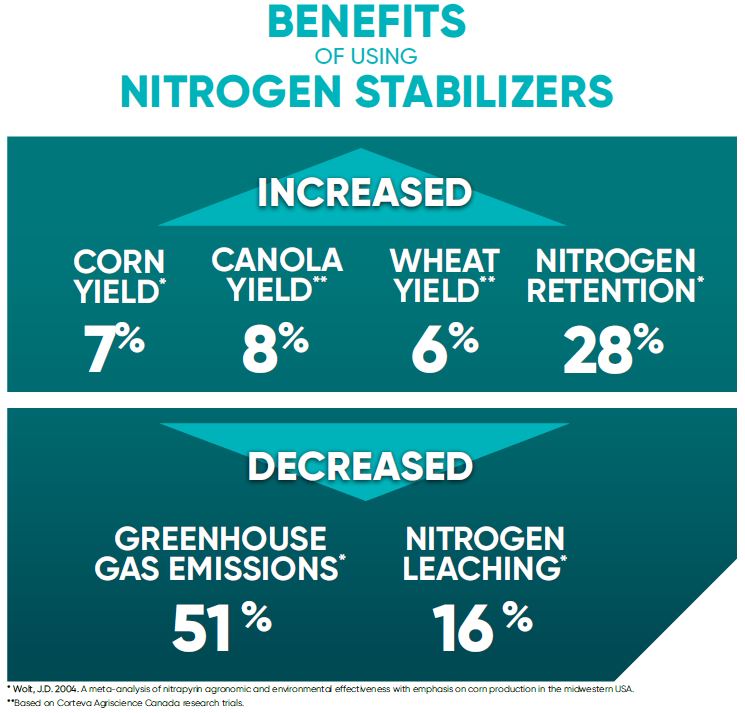Nitrogen is one of the most critical crop nutrients for yield and plant health, but every year it’s a gamble on how much will stay in the soil and be available for crop development when it’s needed the most.
There are a number of nitrogen management options to help keep nitrogen in the stable, positive ammonium form in the root zone, making it available during key growth stages. And given the high costs of nitrogen (and expected environmental losses), maybe this is the year to give nitrogen stabilizers a try.
Nitrogen stabilizers act as an insurance policy against nitrogen loss. They work below ground, maximizing nitrogen's effectiveness and help prevent losses by inhibiting the nitrification process that leads to nutrient loss.
How is nitrogen lost?
Applied nitrogen that is not stabilized in the root zone or utilized by the crop can be lost into the environment. Nitrogen losses are especially significant during early growth stages of the crop when root systems are not well developed.
Nitrogen loss not only affects crop production, but also has environmental implications. Nitrogen leaching can decrease ground and surface water quality and denitrification can lead to atmospheric pollution.
Nitrogen losses commonly approach 25% of the applied nitrogen and can reach as high as 50% - 60% in some situations1.
Beyond environment and crop development implications, nitrogen loss is very expensive. For example, conventional nitrogen fertilizer can be subject to losses varying from 25% - 60% depending on environmental conditions. That translates to economic losses of more than $20 - $50 per acre2 depending on application rate.
1Cassman, K.G., Dobermann, Walters, 2002. Agroecosystems, Nitrogen-Use Effiency, and Nitrogen Management. Agronomy & Horticulture – Faculty Publications. Paper 356.
2Estimates based on $1000/MT of Urea (46-0-0) and a 100 lb/acre application rate. Prices as of June 10, 2022.
How do nitrogen stabilizers work?
Nitrogen stabilizers slow the conversion of ammonium to nitrates, reducing leaching and denitrification. Products like eNtrench NXTGEN™ work effectively to keep nitrogen in the stable, positive ammonium form in the root zone, and ensure nitrogen is available during key growth stages.
eNtrench NXTGEN contains Optinyte™ technology that slows the nitrification process in soils. As the technology works, the nitrogen is stabilized and remains in the soil in the ammonium form in the root zone. The result is nutrient retention for a longer period of time, allowing for better crop utilization rather than being lost to the environment.
What can nitrogen stabilizers do for my fields?
Nitrogen stabilizers like eNtrench NXTGEN protect your nitrogen investment and can help retain 28% more nitrogen in the soil longer so it’s available when crops need it for maximum growth. And given the rising cost and supply chain interruptions of inputs like nitrogen, a nitrogen stabilizer is important to help protect one of the most valuable inputs on your farm.
Since eNtrench NXTGEN acts on the bacteria in the soil, not nitrogen, it’s rate of application is calculated by the acre rather than by the amount of nitrogen applied. eNtrench NXTGEN is designed for use with urea, UAN and liquid manure. Product application timing is flexible too – in fall or spring with urea and liquid manure, pre-plant with urea or UAN or in-crop with side-dressed UAN in corn. And with a more concentrated formulation, farmers are also noting how easy eNtrench NXTGEN is handle.
If you are on the fence about trying a nitrogen stabilizer for the first time, consider applying it to marginal soil like clay and sandy soils that are prone to denitrification and leaching where you may see the most difference. Economics also make for a great incentive to try a new approach to get the most out of nitrogen, especially with the rising cost of fertilizer.
Benefits of eNtrench NXTGEN nitrogen stabilizer:
- Protect your nitrogen investment by retaining 28% more nitrogen in the soil
- Optimize yield and profit potential with average yield increases of 8% in canola, 7% in corn and 6% in wheat1
- Reduce environmental impacts by stabilizing nitrogen (when used with urea, UAN 28% or 32% or liquid manure) and reduce nutrient loss through leaching or denitrification
For more information about how nitrogen stabilizers can benefit your fields, contact your local retailer or Corteva Retail Territory Manager.
1Based on Corteva Agriscience Canada research trials.






